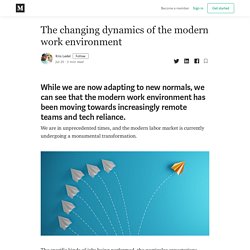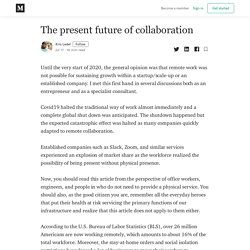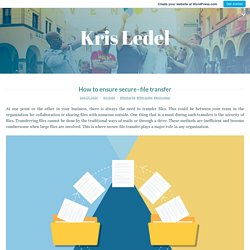

Kris Ledel
Kris Ledel is the founder of two tech scale-ups. He experienced both acquisition and failure. He is a Technology Evangelist. He is currently residing at Weavy out of Los Angeles.
The changing dynamics of the modern work environment. We are in unprecedented times, and the modern labor market is currently undergoing a monumental transformation.

The specific kinds of jobs being performed, the particular expectations, habits, and practices of employees, and the distinct tools available within the workplace are all evolving in unprecedented ways. In particular, we’re witnessing: As the most recent data show, today’s businesses are embracing collaboration-based tools and platforms like never before. The July 2017 McKinsey Global Survey, which collected questionnaire responses from 2,200 business executives from a range of different regions, industries, company sizes, functional specialties, and tenures, found that: As work becomes increasingly remote, complex, and inter-connected and as employees’ expectations for more autonomy, efficiency, and technological flexibility grow, companies must continuously adapt their operations by providing employees with the specific tools they need to produce great work together.
The “collaboration paradox” and what we can do about it – Kris Ledel. We’re facing a paradox when it comes to collaboration: More apps and tools to help us collaborate better, but with less effectiveness in the execution.

Scott Schreiman provides the following hypothetical — but undoubtedly very common — workplace experience as an example of the paradox we’ve been discussing so far: “Somewhere there’s a cloud storage system that has a version of [a] report [you need] on it. But hang on a minute. You don’t know if it’s the most recent version of that report. Maybe a couple [of] team members talked about it and modified the report an hour ago. Now you go into your meeting, ignorant of the latest information, but making decisions anyway. This is efficiency? Perhaps we could just chalk this up to an irresponsible employee who doesn’t know how to “stay on top of stuff”: maybe he’s forgetful and lazy, with only himself to blame for “being left behind” by the rest of his team.
Importantly, however: Others agree with this sentiment, insisting that: U.S. Article Source: 5 ways to adapt your software to remote workers – Kris Ledel. We’re all struggling with the uncertainty of the future, but there are some ways that you can help your users get used to the new norm.

Adapt and overcome. This past Friday, I logged into a Zoom call and was immediately greeted by a group of my laughing coworkers. The sight of familiar faces filled my thirteen-inch screen, and a wave of comfort washed over me. We were having a digital fika, which means “a coffee and cake break” in Swedish. Some opt to swap the coffee for pinot because we are living in different timezones. It is nice to see people in their own homes. My team is no stranger to these types of meetings. However, we know this is not the case for most teams who have recently been exposed to this transitioned work environment. With this spiking transition to remote work, Microsoft CEO Satya Nadella predicts there will be a “fundamental structural change in how we transcend some of these geographic boundaries as a result of the crisis.” 1. The present future of collaboration. Until the very start of 2020, the general opinion was that remote work was not possible for sustaining growth within a startup/scale-up or an established company.

I met this first hand in several discussions both as an entrepreneur and as a specialist consultant. Covid19 halted the traditional way of work almost immediately and a complete global shut down was anticipated. The shutdown happened but the expected catastrophic effect was halted as many companies quickly adapted to remote collaboration. Established companies such as Slack, Zoom, and similar services experienced an explosion of market share as the workforce realized the possibility of being present without physical presence. Now, you should read this article from the perspective of office workers, engineers, and people in who do not need to provide a physical service. According to the U.S.
The new norm of working has gone a long way in addressing the work/life balance challenges faced by most modern 9–5 workers. //Kris Ledel. How to ensure secure–file transfer – Kris Ledel. At one point or the other in your business, there is always the need to transfer files.

This could be between your team in the organization for collaboration or sharing files with someone outside. One thing that is a must during such transfers is the security of files. Transferring files cannot be done by the traditional ways of mails or through a drive. These methods are inefficient and become cumbersome when large files are involved. This is where secure file transfer plays a major role in any organization. Simply put, secure file transfer is the sharing of data through a secure and reliable delivery channel or method. SFTP (Secure File Transfer Protocol)FTPS (File Transfer Protocol –Secure)HTTPS (Hypertext Transfer Protocol – Secure)AS2 (Applicability Statements 2) Secure File Transfer Protocol – SFTP SFTP is an encrypted network protocol that transfers files with SSH connection (Secure Shell). File Transfer Protocol – FTPS Hypertext Transfer Protocol Secure – HTTPS Time: Integrations: